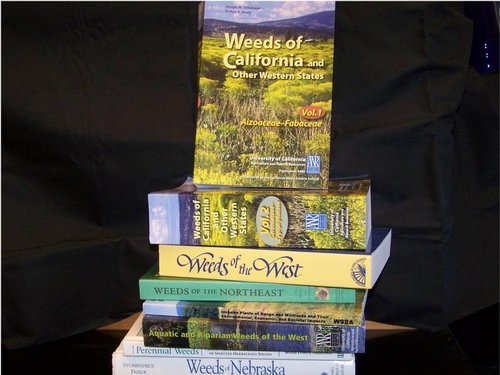Recently I was reminded that there is no more important fundamental to weed control than being able to identify your weed problem.
This summer, I moved to a different house and have slowly been working on little projects that arise. One of these has been figuring out what weed problems I bought along with the house – in my case, this has (so far) turned out to be creeping woodsorell (Oxalis corniculata) in my lawn areas and Bermuda buttercup (Oxalis pes-caprae) almost everywhere else (beds, garden, potted plants)! I’ll save my trials and tribulations with Oxalis management for another day; however, UC-IPM has a nice pest management guideline on Oxalis authored by LeStrange, Elmore, and Cudney here: http://www.ipm.ucdavis.edu/PDF/PESTNOTES/pncreepingwoodsorrel.pdf if you want more information on those weeds.
At any rate, while spraying the woodsorell in my front yard with a mixture of 2,4-D, MCPA, dicamba, and MCPP (available to homeowners), I started talking to one of my new neighbors about weeds. He said "I’ve been fighting crabgrass in my grass and flower beds and just can’t get it under control". I told him that, since it was fall and crabgrasses are summer annuals, it was too late this year to do much about the crabgrass he has now but that he should think about a preemergent herbicide this winter or early spring (a UC-IMP crabgrass pest note is available here: http://www.ipm.ucdavis.edu/PDF/PESTNOTES/pncrabgrass.pdf ). However, during or conversation, it started to become clear that we were not talking about the same weed so I walked over and looked at his "crabgrass" problem. I could see right away that it was a nutsedge infestation and I first thought it was yellow nutsedge (Cyperus esculentus) but after digging up a few plants I found "chains of tubers" indicating that it was purple nutsedge (Cyperus rotundus) instead. You can see a nutsedge pest note here: http://www.ipm.ucdavis.edu/PDF/PESTNOTES/pnnutsedge.pdf
Information on the biology and management of those weeds is available in the links I provided above but suffice it to say that the management of nutsedges is VERY different from crabgrasses. Now, because of proper weed identification, my neighbor knows what his weed problem actually is and will likely save both time and money and will have a much greater chance for successful management of his weeds.
The need for proper weed identification is probably even more important in agricultural operations where they are not just a cosmetic issue. Weed problems affect crop productivity, field operations, and the economics of the farm. Additionally, commercial farmers and weed control businesses have many more choices for herbicides compared to homeowners and specific weed control spectrums can vary tremendously among herbicide products. Knowing your weeds is important to ensure that you are making effective, economical, and environmentally sound choices.
I’m attaching a few slides on weed identification from a presentation I gave a few weeks ago. Part of this information was, ahem, "borrowed" from other California weed extension folks and some is available in other formats. To me, the most important part of the slides is the weed ID tools. There are two basic weed ID tools that I use; the first is books and pamphlets and the second is electronic "keys". For the record, I don’t profit in any way from recommending any of these books or ID tools – these are just the ones that I use on a regular basis.
Books: since I’m a weed guy, I have a whole shelf full of weed books. If I had to pick one set to have at my fingertips, I would have Weeds of California and other Western States by DiTomaso and Healy – this is an 1800 page, two-volume set with thousands of photos of plants, seedlings, seeds, and plant structures ($60-85, depending on where you buy). If I had to have only one book that I was going to carry around with me, I would probably use Weeds of the West (I actually have copies in my office, home, trucks, etc) – this is currently $34 if you buy it from the Western Society of Weed Science.

Electronic ID tools: Looking at picture books has its limitations for identifying weeds and I am not a taxonomist so using dichotomous keys has not always helped me successfully identify plants. Happily, there are tools available that combine the power of dichotomous keys with photos for those of who know a little about plants. Basically, in either online or software versions, you check-off or select features of your plant and a list of possibilities is narrowed down. Once you get the possible list of weeds down to a reasonable level, you can look at photos to make a final identification. A web-based (FREE!) tool is available at http://wric.ucdavis.edu/ ("Weed ID Tool" in the lower right corner). This tool currently has 338 broadleaf and 95 grass-like weeds commonly found in California. There are computer-based "expert systems" to identify weeds – these are computer software programs that you either install or run from the CD. Similar to the free tool explained above, the user checks-off as many characteristics of the plant as they are able and the software narrows down a list of choices and you can look at photos to help make the final determination. I use a set called "Broadleaf Weeds of California" and "Grasslike Weeds of California" that was about $60 for the set. I also have used an earlier version of "1200 Weeds of North America" (the previous version only has 1000 species…) and I know there are other computer-based weed ID tools available.

Not all weeds present the same problems, not all control measures work equally well on all weeds, and uniformed decisions can sometimes be poor decisions. If you are making weed control decisions, you should consider arming yourself with the tools to properly identify your enemy.